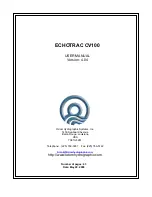
fish appear to have the same strength (color) irregardless of the depth.
When you select Analog Time-Varying Gain you will be asked to provide
two different gain values - the start gain (gain at the surface) and he rate
of change of the gain (how fast you want the signal gain to increase).
Selecting these two values is a function of trial and error until you find
settings that work for your particular situation. Remember, once you
find settings that works well for you, you can save those setting with a
name and load them back any time.
Digital signal processing (DSP) enables the PC Fishfinder to go deeper
and see smaller objects (fish) without increasing the power normally
required to do so. The penalty you pay for using DSP is that the resolution
is not as good in shallow water. Use the DSP modes only in deeper water
where the analog modes no longer provide a strong enough signal return
to work properly.
Each of the two DSP modes Type 1 and Type 2 provide different
advantages. Digital Processor Mode 2 offers the highest level of signal
improvement but works on a “probability” process which results in the
signal strength fading in and out. Digital Processor Mode 1 offers less
signal strength improvement but provides for a more constant signal
without as much signal fade as Digital Processor Mode 2.
Depth Range
The Depth Range value sets the depth scale from the top of the display to
the bottom of the display. A selection of 100 feet will result in a depth
range of 100 feet from the top of the display to the bottom of the display.
This does not mean that the top of the display will be zero and that the
bottom of the display will be 100 feet because the Depth Offset will affect
these settings. For example with the Depth Range set to 100 feet and the
Depth Offset set to 250 feet the top of the display will be at 250 feet and
the bottom of the display will be at 350 feet (a Depth Range of 100 feet).
Page 37



























